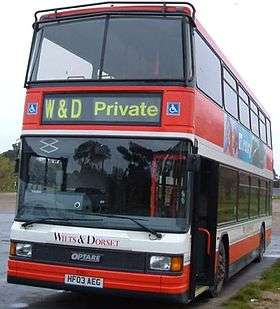Optare Spectra
Launched in 1991, the Optare Spectra was a double-decker bus body built on the DAF (now VDL) DB250 chassis. The vehicle was developed as a joint project between Optare and DAF; it was based on the designs of the successful MCW Metrobus[2] which had been jointly purchased by DAF and Optare,[3] but they are by no means a restlyed Metrobus. With the launch of the DB250LF chassis sometime after production commenced, the Spectra was built to low-floor specification, and was one of the first low-floor double-decker buses available in the United Kingdom.[4] The design is notable for the exclusion of a lower deck rear window,[5] a practice that has become more commonplace. The bus typically seated 47 on the upper deck and 28 on the lower deck in single-door format. [6]
| Optare Spectra | |
|---|---|
 Wilts & Dorset Spectra bodied DAF DB250LF in Bournemouth in 2005 | |
| Overview | |
| Manufacturer | Optare |
| Body and chassis | |
| Doors | 1 or 2 doors |
| Floor type | Step entrance/Low floor |
| Chassis | DAF/VDL DB250 |
| Powertrain | |
| Engine | DAF [1] |
| Dimensions | |
| Length | 10.5m, 11m |
| Width | 2.5m |
| Chronology | |
Operations
A large batch was supplied to Reading Buses, including the first production model (fleet number 701),[7] all of which have now been sold, with 701 & 721 being preserved.[8]
London Central also received a batch of 24 of these, with a single door arrangement. East London received one example which had a dual door layout.
Several were built for Turkey, with 26 new to IETT, Istanbul, and 5 going to İzulaş, İzmir.[6]
Low floor examples
The first completed low-floor Spectra was received by National Express in January 1998, R1 NEG, body Number 8620.[9] However, the first low floor example of the Optare Spectra to enter service was with Peters, Bristol, more commonly known as Abus, at 0650 on Wednesday 4 February 1998. This saw R222 AJP becoming the first low floor fully accessible double deck bus to enter service in Great Britain. It was only by chance that Peters found out that West Midlands were planning to launch their Spectra at midday the following day, when he went to pick up the Spectra from Arriva Bus & Coach, allowing it to be prepared and be ready for service the following morning. The bus was destroyed by fire in 2015. [10]
National Express received the first two low-floor Spectras in 1998, allocating one to Travel West Midlands and one to Travel Dundee, with registrations of R1 NEG & R2 NEG, their original fleet numbers being 1 & 2. They entered service on 15 January 1998, with branding reading Britain's first "Low Floor Low Emissions Easy Access Double Decker" and Scotland's first "Low Floor Low Emissions Easy Access Double Decker" A batch of 20 buses were purchased in 1999, and allocated to Travel West Midlands, to upgrade route 50 (Birmingham - Druids Heath) from Scania N113DRB operation. R2 NEG was also transferred to Travel West Midlands in August 1999 so all the National Express' Spectras were operated by Travel West Midlands, where 1 & 2 were re-numbered 4001 & 4002 to give them the same fleet numbers as the rest of the Spectras. They were replaced on the 50 in late 2001 by Volvo B7TL/Alexander ALX400s. They were transferred to Wolverhampton in the summer of 2009, to replace the final MCW Metrobuses allocated there, and were operated on various routes across the city, with the new NXWM livery and digital destination blinds. All examples in the fleet have now been withdrawn (September 2016) with 4014 (T414 UON) destroyed by fire in 2001. After 17 years of service, R1 NEG (4001) was donated to the Transport Museum, Wythall on 19 June 2015.[11]
Three low-floor Optare Spectras were also delivered to Isle of Man Transport, now Bus Vannin, in 2000.
Demise
Production of the Optare Spectra ceased when the final two rolled off the line in late 2006. The last Optare Spectra was built for Anglian Bus, who later sold it to Auckland Explorer, in Auckland, New Zealand.[12]
See also
References
- "Optare reveal DAF's secret". Commercial Motor. 11 June 1992. p. 18. Archived from the original on 16 July 2019. Retrieved 16 July 2019.
- "Top ten British buses". The Independent. 12 October 2004. p. 9. Retrieved 27 May 2015. (subscription required)
- "Optare and DAF in joint venture on buses". Reuters News. 6 October 1989. Factiva lba0000020011129dla6062za.
- "West Midlands Optare Spectra - R1 NEG". Transport Museum Wythall. Retrieved 9 December 2018.
- Graff, Vincent (1 March 1993). "The man on the Clapham omnibus". Evening Standard. p. 34. Retrieved 27 May 2015. (subscription required)
- "Optare Spectra". Bus lists on the web. Retrieved 9 December 2018.
- "Green claim for Spectra". Commercial Motor. 13 February 1992. p. 24. Archived from the original on 16 July 2019. Retrieved 16 July 2019.
- "Spectra Bus Zone". Bus Zone. Retrieved 7 June 2014.
- "Bus Lists on The Web". www.buslistsontheweb.co.uk. Retrieved 8 June 2015.
- "Abus - The History" (PDF). abus.co.uk. Archived from the original (PDF) on 12 February 2015. Retrieved 12 February 2015.
- "'WM Bus Photos - Optare Spectras". wmbusphotos.com. Retrieved 4 September 2016.
- "Omnibus Society - Fleet Notes". www.omnibus.org.nz.